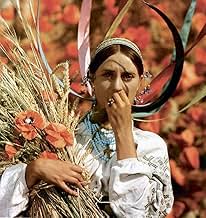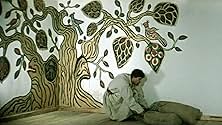NOTE IMDb
7,3/10
544
MA NOTE
Piotr est un modeste ouvrier agricole vivant dans un village pauvre. Il veut épouser la belle Pidorka, mais le père de celle-ci ne veut pas. Heureusement, le malicieux démon Bassaruv, en lib... Tout lirePiotr est un modeste ouvrier agricole vivant dans un village pauvre. Il veut épouser la belle Pidorka, mais le père de celle-ci ne veut pas. Heureusement, le malicieux démon Bassaruv, en liberté dans le pays, lui propose un marché.Piotr est un modeste ouvrier agricole vivant dans un village pauvre. Il veut épouser la belle Pidorka, mais le père de celle-ci ne veut pas. Heureusement, le malicieux démon Bassaruv, en liberté dans le pays, lui propose un marché.
- Réalisation
- Scénario
- Casting principal
Avis à la une
this, a film of a short story by nicolai gogol(inspired by a ukrainian fairy tale)tells the story of piotr, who is merely a poor farmer and in need of money to marry his great love. he's helped by a demon called bassaruv who offers him more gold than he could count for bringing him a flower from the forests at night. when they meet, piotr sees that his task deviates from the original contract: the demon forces him to kill a small child for the loot. greedy for love, piotr does so. he can now marry his girl, but suffers all day long lethargically. the movie is an outstanding example of surrealism using surprising, at times twisted and confusing techniques and creating an unparalleled atmosphere. there are moments of hilarious slapstick as well as sheer horror and everything in between,but this combines to a complete entity and doesn't make the film silly or seem unprofessional. but what a shame: there's no way to get hold of it today! as far as i know, it's never been released in the western democracies during cold war, and it still is impossible to get a copy of it today. i've only seen it twice: as a lad (5 years old or so) in gdr and in spring 2001 in paris, where it was aired by the cultural tv channel arte. IF I JUST COULD HAVE RECORDED IT THERE !!!!!!!! but this doesn't change my opinion about it as it has become one of my all time favourites and i hope someday this masterpiece will be available to all of us (especially me).
This film is now available on DVD in Russia, but there's no distributor name on the packaging (I bought it at a 505 store in St. Petersburg).
This is a little new wave gem. It's reminiscent of Sergo Paradjanov's "Shadows of Forgotten Ancestors" (1964) -- Ilyenko was Paradjanov's cameraman and both worked for Dovzhenko Studios in Kiev. Paradjanov's film (based on the Kotsiubynsky story of the same name) is set among the Hutsuls of western Ukraine while Ilyenko's takes place in central Cossack Ukraine. The considerable cultural differences are overcome by the similar approach to the material -- some critics use the term "Ukrainian Poetic Cinema" for the films made by the group around Paradjanov and Ilyenko, and you can read a fine article about them by Bohdan Nebesio on-line. Ilyenko went on to make "White Bird with a Black Spot," which I saw as an undergrad at UM and now have only the vaguest memory of; and the 2002 "Prayer for Hetman Mazepa" which had a very stormy reception.
The packaging says that this is a "poetic fantasy on the motifs of the stories of N. V. Gogol and Ukrainian folk tales." That's about right: the plot loosely follows Gogol's story, and also includes moments from the other "Dikanka" stories (the pig busting in on the Cossacks is especially nice), as well as from Ukrainian folk rituals.
This is a little new wave gem. It's reminiscent of Sergo Paradjanov's "Shadows of Forgotten Ancestors" (1964) -- Ilyenko was Paradjanov's cameraman and both worked for Dovzhenko Studios in Kiev. Paradjanov's film (based on the Kotsiubynsky story of the same name) is set among the Hutsuls of western Ukraine while Ilyenko's takes place in central Cossack Ukraine. The considerable cultural differences are overcome by the similar approach to the material -- some critics use the term "Ukrainian Poetic Cinema" for the films made by the group around Paradjanov and Ilyenko, and you can read a fine article about them by Bohdan Nebesio on-line. Ilyenko went on to make "White Bird with a Black Spot," which I saw as an undergrad at UM and now have only the vaguest memory of; and the 2002 "Prayer for Hetman Mazepa" which had a very stormy reception.
The packaging says that this is a "poetic fantasy on the motifs of the stories of N. V. Gogol and Ukrainian folk tales." That's about right: the plot loosely follows Gogol's story, and also includes moments from the other "Dikanka" stories (the pig busting in on the Cossacks is especially nice), as well as from Ukrainian folk rituals.
I was very lucky recording this movie on VHS in 2001 on the french / German Arte TV-Channel. It's in the same line as Sergei Parjanov's "shadows of forgotten ancestors" from 1964. Yuri Iljenko did most of the camera work for "Shadows". An everyone who nows the Parajanov movie is familiar with the brilliant camera techniques of Yuri Iljenko. Although the story of "Vecher nakanune Ivana Kupala", a Russian folklore-myth is interesting, i was a lot more impressed by the fantastic, unusual and hypnotic camera work of brother Vadim Iljenko. The film is throughout filled with all kinds of colors in a very consentaneous way, and there are scenes with slapstick-parts you'll probably see for the very first time in a movie. In one scene there are many fireballs made out of straw rolling down a hill at night. It's made very simple but the effect is so wonderful, you just sit there watching this stunning, natural beauty. It's definitely not a film for Hollywood buffs. But if you like something different you've never came across, therefore i would highly recommend this movie. As been said, it was, or maybe it is possible to buy this movie in Russia. But i've never seen a VHS or DVD on the internet. The only chance to see this film is probably to ask the ARTE TV-channel for a copy. In my opinion it would be worth it. 10/10 **********
Le saviez-vous
- AnecdotesCritic John Powers once called this "one of the four or five most visually amazing movies I've seen."
- ConnexionsFeatured in Horrible Reviews: Best Movies I've Seen In 2023 (2024)
Meilleurs choix
Connectez-vous pour évaluer et suivre la liste de favoris afin de recevoir des recommandations personnalisées
Détails
- Date de sortie
- Pays d’origine
- Langue
- Aussi connu sous le nom de
- La nuit de la veille de la Saint-Jean
- Société de production
- Voir plus de crédits d'entreprise sur IMDbPro
Contribuer à cette page
Suggérer une modification ou ajouter du contenu manquant

Lacune principale
By what name was La Nuit de la Saint-Jean (1968) officially released in Canada in English?
Répondre

























